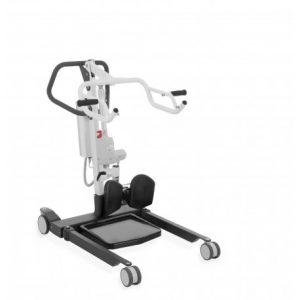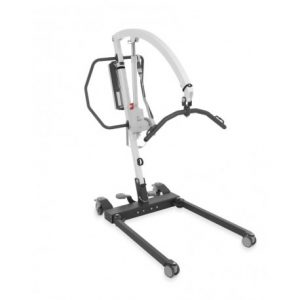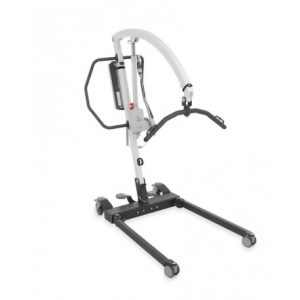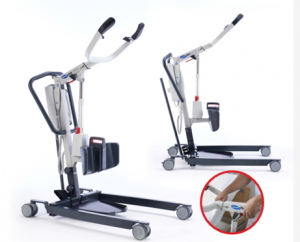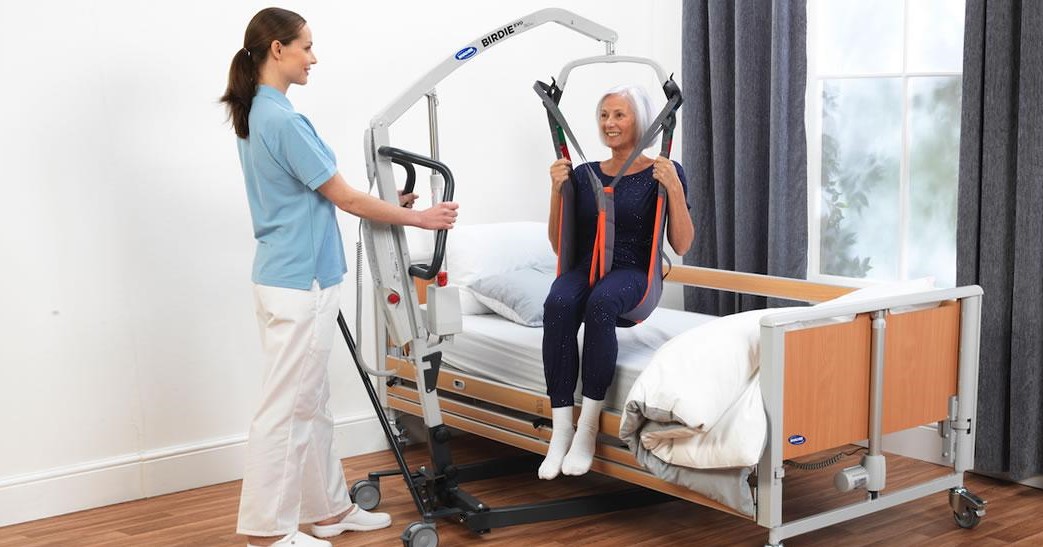
Knowing how to use a hoist step by step is an essential skill for many health workers and carers. Hoists are widely used in hospitals and clinics, but they also form a crucial part of the basic equipment that a carer needs to assist immobile patients at home. Hoists have many practical applications and make it easier for both the carer and the patient to perform daily activities like taking a bath or transferring from a bed to a wheelchair. In addition to this, using a hoist makes it more comfortable for the patient to perform these activities and prevents the carer from developing ailments such as a bad back. Let’s take a closer look at how a stand assist hoist is used.
How to Use a Sling Hoist Step by Step
Although there are a variety of hoist types available, sling hoists are one of the most widely used models. These flexible hoists can be used to lift patients out of bed or assist someone to get up from the floor. Sling hoists can also come in mobile form, allowing them to be used to move patients across short distances. As is the case with all medical equipment, the operator must understand exactly how to operate the hoist safely. The below steps are a general guideline, but operators should always consult the instructions that came with a specific hoist before using the device:
Confirm the Patient’s Weight
Patient hoists should clearly indicate their maximum lifting capacity. Before attempting to lift a patient make sure that the patient’s weight does not exceed the hoist’s maximum capacity. This is especially important in the case of mobile hoists.
Plan the Route and Ensure that it is Free of Obstacles
It is important to ensure that the patient can be transferred smoothly and that there are no obstacles in the way. Plan the route that you will take ahead so that there are no surprises that can cause injuries to yourself or the patient.
Choose an Appropriate Sling
All slings are not created equally so it is important to choose the right sling for the patient and application. Some slings are designed for patient transport while others can be used to assist with tasks such as bathing.
Help the Patient onto the Sling
The next step is to help the patient get onto the sling. The exact procedure depends on the location from which the patient will be lifted, the easiest procedure is lifting the patient from a hospital bed. To do this, assist the patient to roll onto their side and place the sling against the patient’s back, ensuring that the sling is fully spread out before gently rolling the patient back onto the sling. The same procedure should be repeated for the other side so that the patient is fully supported by the sling.
Attach the Sling to the Hoist
Move the hoist into position so that it can be attached to the sling. It is important to ensure that the attachment instructions are followed precisely, and all attachment points should be double-checked before using the person hoist to lift the patient.
Begin Lifting the Patient
After you have double-checked that the hoist is correctly configured, you can slowly begin lifting the patient. It is important to lift the patient high enough that they are fully suspended to avoid the sling snagging as you begin moving the patient. Now the patient can be moved or transferred into a wheelchair. It is important to note that most hoists are not designed to transfer patients over longer distances and a wheelchair should instead be used for this purpose.
Storing a Mobile Hoist
Mobile hoists can become an obstacle when they are not in use so it is important to store them somewhere where they will not be in the way. Since most mobile hoists come with a rechargeable battery, it might be clever to store them in an area where they can also be charged.
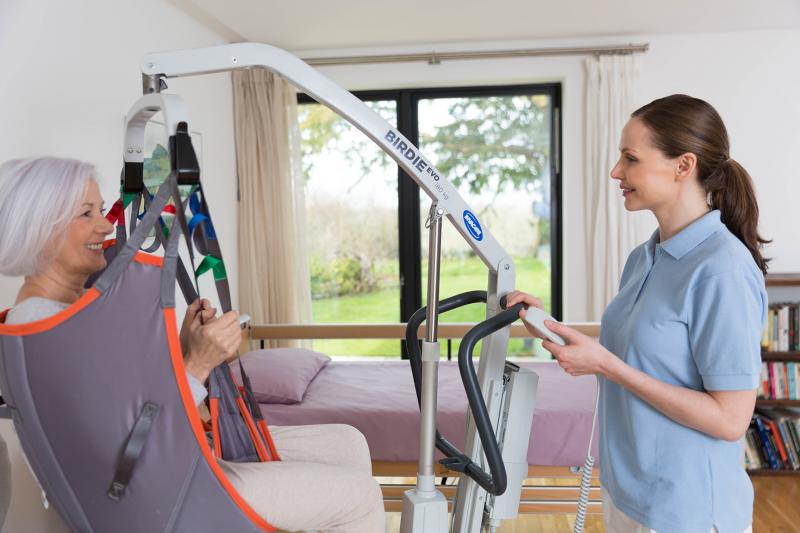
Using a Bath Hoist
Bath hoists are designed specifically to assist a patient in and out of a bath. These hoists are usually mounted to the floor and cannot be moved. Bath hoists have a few specific usage requirements, including:
Check the Environment
As these hoists are used in a bathroom, there is always a risk of slipping. Ensure that the floor is dry and wear footwear that is suitable so that you do not slip as you assist the patient onto the hoist.
Check the Patient’s Seating Position
After you have assisted the patient to transfer onto the hoist, make sure that they are seated centrally on the hoist chair. This way the patient cannot easily fall from the chair as the hoist is being used.
Check the Bath Water
Before lowering the patient into the bath, make sure that the water is at a suitable temperature to prevent injuries.
Using a Ceiling Track Hoist
The procedure of placing a patient onto the sling for a ceiling track hoist is similar to the procedure for a mobile hoist. However, particular care should be taken to ensure that the track is secure and that the sling is not damaged in any way before using the lift.
Maintaining a Hoist
Safety is paramount when using person hoists. Every hoist model comes with its own maintenance instructions and requirements which should also be followed to ensure that the hoist remains safe to use. However, you should always check the hoist for any obvious signs of a problem before using it.
What are the Different Types of Hoists that are Available?
At O’Flynn Medical we offer a variety of hoists. Our hoists can be purchased outright but we also offer a rental service. Some of the models in our range include:
Invacare Birdie Evo
The Invacare Birdie Evo is a mobile hoist that offers comfort and security when lifting patients and can be used to lift someone from a bed, chair, or even the floor. The hoist supports up to 180 Kgs.
Levitop Standard Full Body Patient Floor Lift
The Levitop Standard Full Body Patient Floor Lift is specially designed to help patients who are temporarily or permanently unable to stand without assistance. The hoist can be used to lift patients from a variety of surfaces and comes with a secure 4-point sling attachment and remote control.
Lifteo – Full Body Patient Floor Lift
The Lifteo – Full Body Patient Floor Lift is ideal for patients who need support to stand on a permanent or temporary basis. The hoist is equipped with a foot pedal mechanism that allows the base legs to be extended for additional stability.
Verteo – Sit-to-stand Lift
The Verteo – Sit-to-stand Lift is designed to assist patients that have difficulty standing up from a seated position. The hoist can be used to help patients to transfer from one seating area to another. The hoist is equipped with flexible tibial support.
Invacare ISA Sit to Stand
The Invacare ISA Sit to Stand is a unique hoist is designed to lend a helping hand to patients who need some support to rise from a seated position. The hoist is very flexible and can adjust to the needs of a wide variety of patients.
Conclusion
The importance of hoists cannot be overemphasised, and they make it easier for both patients and carers in everyday situations. If used properly, hoists are very safe, and they give patients much-needed independence. Knowing how to correctly use a hoist is a skill that every medical professional or carer should have.
Contact O’Flynn Medical today to get advice on the right patient hoist for your needs. With flexible purchase and rental options and unmatched expertise, O’Flynn Medical is the destination for all your person hoist needs.
You might also be interested in the following article:


